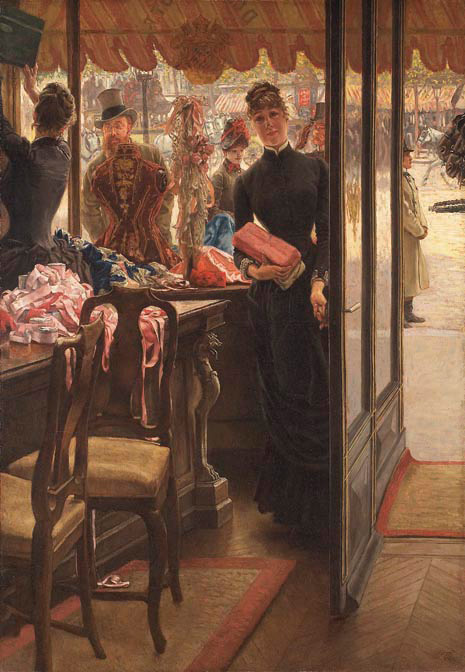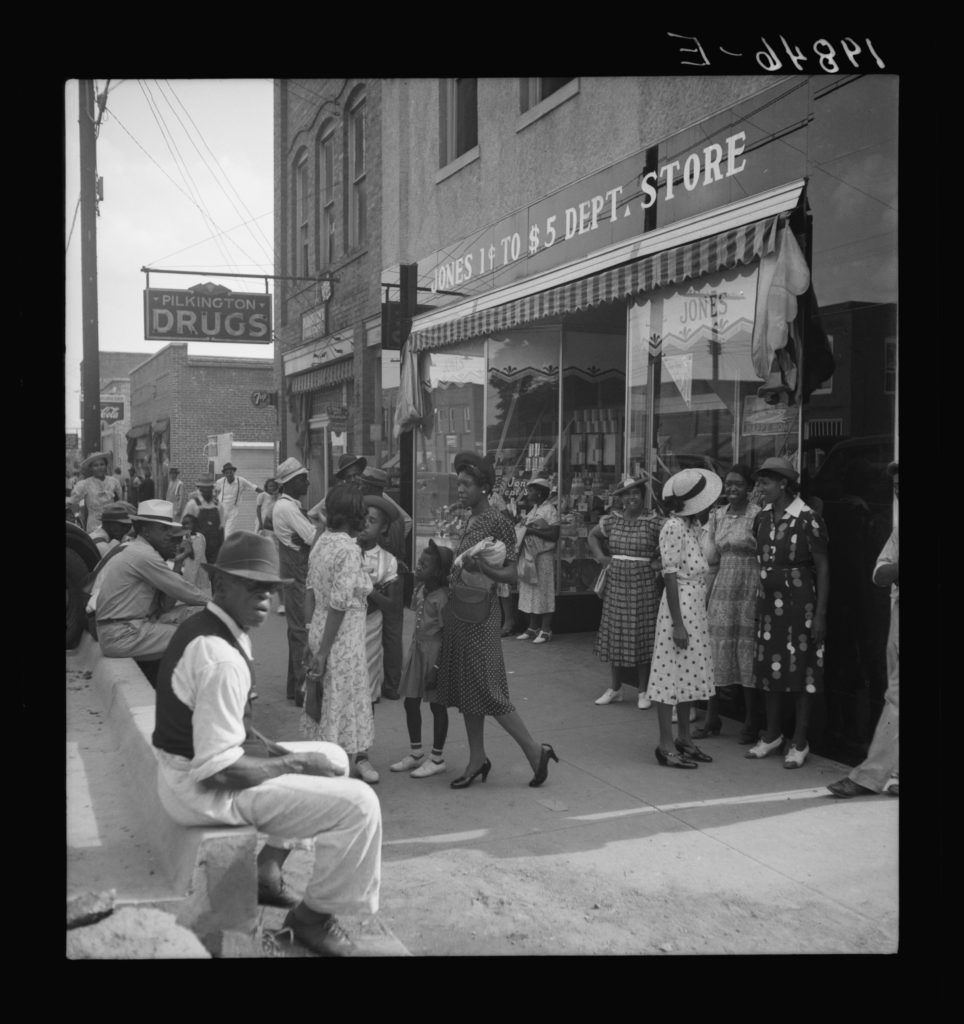Subject Areas
Business Organization and Management Courses
Career Description
Beginning in the second half of the 19th century, the increase in consumer culture and the advent of department stores gave rise to a new career: the salesperson, or “shop girl.” The salesperson was an overwhelmingly female occupation, as it was considered one of the few entry-level positions suitable for women that did not involve dangerous physical exertion (unlike agricultural or industrial labor). Note that women were not just the majority of workers but also comprised the majority of clients, and thus this experience was a significant way that women of different classes communicated with each other. The “shop girl” is often represented as both ambitious and hard-working but, because she served male clients and also was required to be very visible and friendly, at times the “shop girl” was considered to be more sexually promiscuous than women working in clerical positions.
By the late 20th century, the retail industry began to change and by now, the term “shop girls” is antiquated. The preferred term “sales associate” suggests a position that has room for career advancement into supervisory and management positions, and is no longer one in which the moral status of the salesperson is called into question. The duties of the salesperson remain relatively consistent with its origins however and include: greeting and assisting customers, giving suggestions and sharing knowledge about the products, assisting with the stocking and display of merchandise, and executing sales.
Even though we call this section “Shop Girls,” the sector has been and remains open to all genders. However, these lesson plans focus strongly upon the gendered history of the career as a means of understanding its role in the retail industry and in demonstrating changes in women’s career expectations over the course of the last century and up through today.
Potential Courses
FM 116, Fashion Business Practices; FM 205, Fashion Marketing and Digital Technology; FM 207, Retail Strategies; FM 245, Fashion Forecasting for Merchandisers; FM 326, Sustainability in Fashion Merchandising
Movie clips
Miracle on 34th Street (Seaton, 1947)
This classic Christmas film follows the story of a Macy’s Santa Claus and his relationship with a young girl and her single mother, who occupies a senior managerial position in the store. As the film progresses the mother learns to focus less upon her career and believe once again in romance and her role in the traditional family sphere.
Questions:
- Why is the mother an effective businesswoman, and how is she portrayed compared to her male colleagues?
- How does the mother’s career focus come into contrast with her role as a mother? In your experience, what are the conflicts between work and family life, for both men and women?
- This film was made soon after the end of World War II, when many working women were encouraged to retreat to the domestic sphere and allow returning soldiers to occupy the jobs that women held during their absence. How do current events (political, economic, and social) influence our career expectations?
Keywords: retail management, New York City, department stores, parenthood, work-family balance, gender
Sweet Dream/Mimong (Ju-nam Yang, 1936)
https://www.imdb.com/title/tt2082346/
This is a rare movie showing a sales person and a shopper in a modern department store. The main character Ae-soon abandons her husband and daughter to live with another man who betrayed her trust. Ae-soon encounters a tragic fate. In this scandalous movie, modern shopping in a department store carries layered meanings to the viewers. The store itself is a place of desire.

- How is a working woman (sales person) portrayed in comparison to the main character, Ae-soon, a well-to-do housewife?
- Sales people have to generate revenues. What would have been desirable qualities of sales people in the early twentieth century?
- Shoppers are both men and women while sales people are predominantly women. Why are the elements that generate this assumption of female sales people?
Keywords: retail management, modern, Korea, Asia, department stores, parenthood, consumption, luxury, gender, hybrid fashion
Visual Art

This 19th century French painting depicts two saleswomen in a shop in Paris that sells ribbons and other textiles, and their potential customers on the city street outside.
Questions:
- How does the painting contrast the women within the shop and the people who are outside the shop?
- What is the expression of the man looking in the shop window, and what might be the expression of the other saleswoman whose faces him?
- Describe the salesperson who is looking directly at the viewer. How is she dressed? What does her body stance and expression suggest to you about her job and how she feels about her work?
Keywords: retail, France, boutiques, notions, salespersons, customers

This photograph depicts shoppers outside a store in North Carolina. Although we may or may not see sales people in this scene, we see a lively conversation outside a store.
Questions:
- What do you expect the gender and the race of sales people of this store?
- What would be the nature of this store selling products of one cent to five dollars?
- Would an ethnic enterprise generate more profits? Considering the date of 1939, what would be regulations imposed on sales people?
Keywords: retail, race, gender, salespersons, customers
Literature
Excerpts, Émile Zola, The Ladies’ Paradise (Aux Bonheurs des Dames, 1883)
http://www.gutenberg.org/files/54726/54726-h/54726-h.htm
This novel by the popular Naturalist writer Zola focuses upon the role of women in the relatively new phenomenon of the department store (the author was inspired by the famous Le Bon Marché in Paris). The first chapters focus upon the experiences of Denise, a 20-year-old woman from the provinces who comes to Paris and becomes a salesperson in a large department store. The book depicts the substandard living conditions of the women who work there, while it also describes the strategies used by retailers to appeal to the emotions and desires of their female clients. (NB: This reading is contemporaneous with the Tissot painting, “The Shop Girl”)
Questions:
- What are the differences and similarities between the female salespersons and the female shoppers in the store?
- How does being a salesperson influence not only the work experience but also the personal lives of the women?
- How does your job determine where you live, who you socialize with, what you eat and wear, etc.?
Keywords: gender, retail, France, department stores, urban life, working-class, living conditions, shopping
Popular Music
Belle and Sebastian, “Expectations” (1996)
This song by the Scottish pop band Belle and Sebastian is from the perspective of a teenage girl who is somewhat misunderstood at school. It references her future career prospects and the expectation that she is destined to work in retail in a mid-range department store such as Debenham’s or C&A (both European chain stores).
Questions:
- Why is retail the inevitable job prospect for the girl, and how is that conditioned by her social status at school?
- What are the references to sexual harassment, both in the girl’s current situation and in her future job prospects?
- How does the girl’s own creative desires contrast to the expectations of her by her family/school/friends?
Keywords: youth, education, department stores, retail, lingerie, sexual harassment, working-class
Suggested Secondary Readings and References
Brockbank, Anne and Airey, Yvonne “Women in Retail Management.” Women in Management Review 9, no. 2 (1994): 15-22.
Department Store Museums [many photos of defunct department stores in NYC] http://www.thedepartmentstoremuseum.org/2010/06/bonwit-teller-new-york-city-new-york.html
Retail, Wholesale, Department Store Union [founded in 1937 in New York City] https://www.rwdsu.info/
A job description of a night part-time position:
As A Sales Associate, You Will:
Generate sales by determining customer’s needs.
https://www.snagajob.com/jobs/511913006
Develop and maintain your own clientele.
Develop product knowledge by learning the merchandise features, advantages and benefits.
Open new charge accounts.
Maintain floor standards including replenishment and presentation as well as the general appearance and cleanliness of department.
Understand all systems and procedures relating to sales and credit transactions.
Enforce loss prevention and shortage control procedures.

